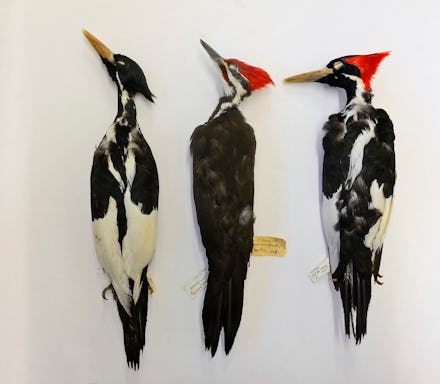The government just declared 22 new animals extinct

Odds are, you've never seen an ivory-billed woodpecker. The stunning and long-endangered avian species has eluded birdwatchers for generations, sending people deep into the swamps of the southeastern United States just to catch a glimpse of the "Lord God" Bird — named supposedly for the refrain that people who managed to spot it would say. But opportunities to see the elusive woodpecker have officially run out: It, along with 21 other species of animals and one species of plant, were declared extinct by the U.S. government on Wednesday.
Joining the ivory-billed woodpecker on the list of species who have entirely disappeared off the face of the Earth: the yellow-breasted Bachman's warbler, the Hawaiian Kauai O'o forest bird, the Mariana fruit bat, eight different species of freshwater mussels, two types of fish, and eight other types of birds. The lone plant to get eliminated from the survivor pool was the phyllostegia glabra var. lanaiensis, a long-endangered plant that liked to hang out in the moist and wet forests of Hawaii.
It's surprisingly uncommon for the government to give up on the search for a species and just place the extinct label on them. According to the International Union for Conservation of Nature, a species can be declared extinct if it has not been spotted for at least 50 years or if there is "no reasonable doubt that the last individual member has died." In some cases, the declaration of death is tragic, but beautiful. What is believed to be the last song of the Kauai O'o bird, a male bird calling out for a female mate who will never come, was captured on tape in 1987. The case of the ivory-billed woodpecker is closer to abandonment of the cause: While birders have sought after the bird for generations and occasionally reported sightings, confirmation of its ongoing existence has not followed. If it does still exist, it does so as a ghost.
The loss of any species to extinction is tragic. It also runs the risk of upsetting an ecosystem. Each species contributes in some form to their environment, whether it's feeding on invasive plants to keep them from taking over or serving as prey to bigger predators that roam the region. When they disappear, so too does a chain holding together the ecosystem.
It's unfortunate that these declarations of extinction are likely to become more common. As the planet warms as the result of human activity, almost every species will see their environment change around them. Many of them will not survive. It is estimated that as many as 1 million species will face extinction over the course of the next few decades. Some experts warn that we are racing toward a sixth mass extinction event, with the rate of death only accelerating as we continue to pump greenhouse emissions into the atmosphere.
Document your favorite plants and animals now. You never know when you might be capturing the last image of a dying species.